Global Business Environment Analysis and CAMECO Case Study Report
VerifiedAdded on 2020/12/23
|11
|2868
|60
Report
AI Summary
This report provides an in-depth analysis of the global business environment, utilizing CAMECO as a case study. It evaluates the influences of globalization on organizational governance, leadership, structure, culture, and functions, while also assessing the impact of ethical and sustainable globalization. The report further examines effective decision-making processes in a global context and explores various routes to internationalization, including licensing, joint ventures, exporting, and the use of the internet, alongside the barriers companies may encounter. The analysis covers relevant frameworks such as McKinsey's 7S Model and Hofstede's cultural dimensions to understand the complexities of operating in international markets. Additionally, the report considers international trade agreements like NAAFTA, WTO, and EU trade agreements, as well as the Kyoto Protocol. The report offers insights into how CAMECO can navigate the challenges and leverage opportunities within the global business landscape.
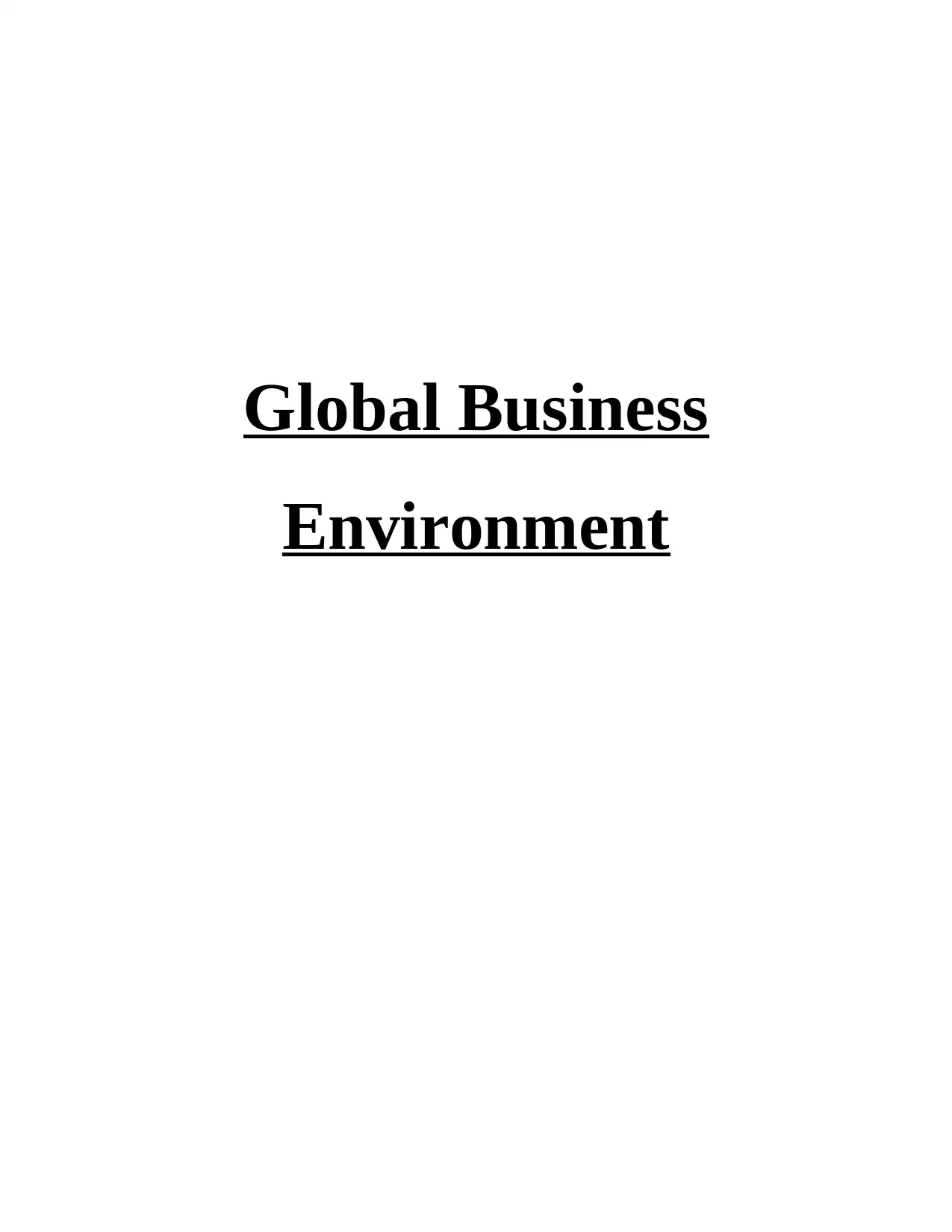
Global Business
Environment
Environment
Paraphrase This Document
Need a fresh take? Get an instant paraphrase of this document with our AI Paraphraser
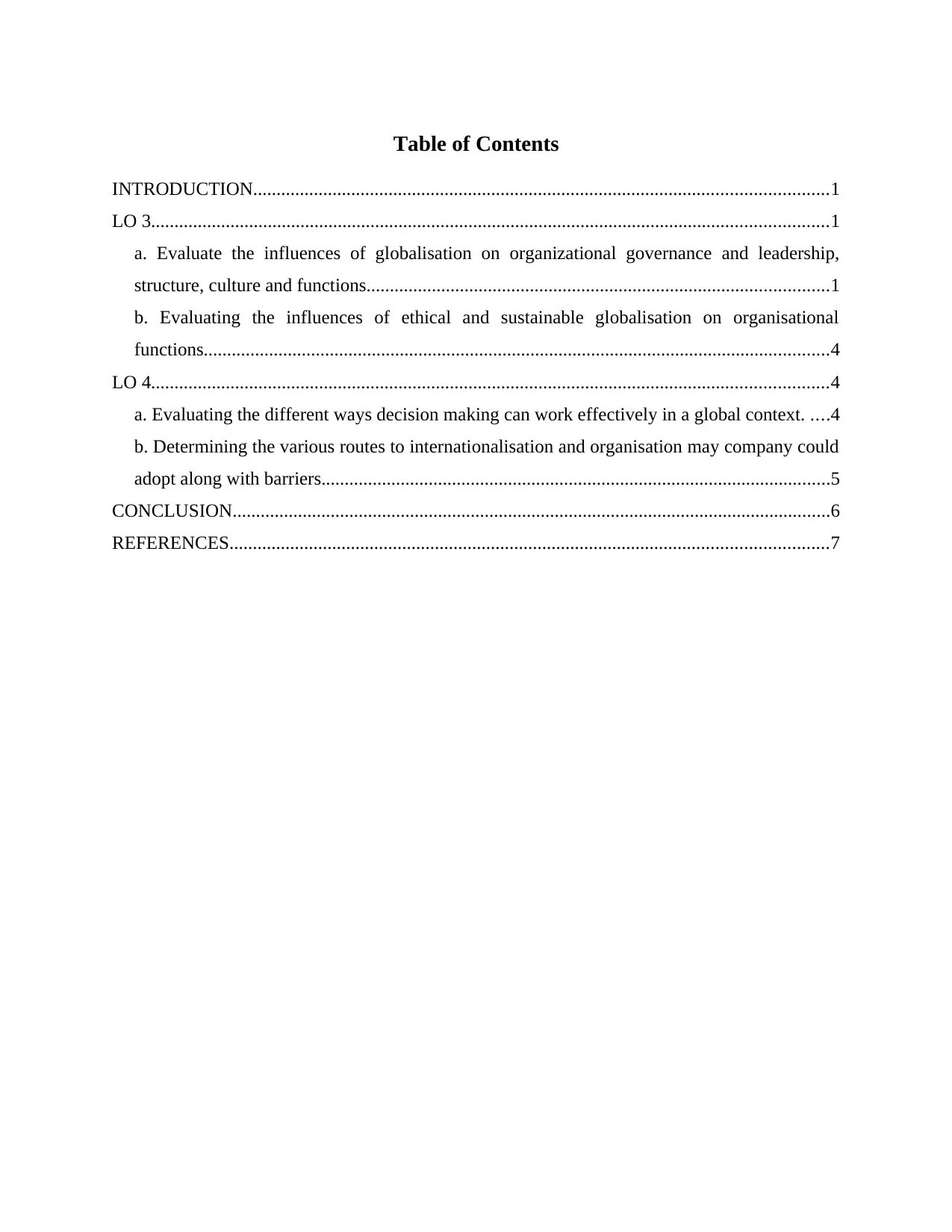
Table of Contents
INTRODUCTION...........................................................................................................................1
LO 3.................................................................................................................................................1
a. Evaluate the influences of globalisation on organizational governance and leadership,
structure, culture and functions...................................................................................................1
b. Evaluating the influences of ethical and sustainable globalisation on organisational
functions......................................................................................................................................4
LO 4.................................................................................................................................................4
a. Evaluating the different ways decision making can work effectively in a global context. ....4
b. Determining the various routes to internationalisation and organisation may company could
adopt along with barriers.............................................................................................................5
CONCLUSION................................................................................................................................6
REFERENCES................................................................................................................................7
INTRODUCTION...........................................................................................................................1
LO 3.................................................................................................................................................1
a. Evaluate the influences of globalisation on organizational governance and leadership,
structure, culture and functions...................................................................................................1
b. Evaluating the influences of ethical and sustainable globalisation on organisational
functions......................................................................................................................................4
LO 4.................................................................................................................................................4
a. Evaluating the different ways decision making can work effectively in a global context. ....4
b. Determining the various routes to internationalisation and organisation may company could
adopt along with barriers.............................................................................................................5
CONCLUSION................................................................................................................................6
REFERENCES................................................................................................................................7
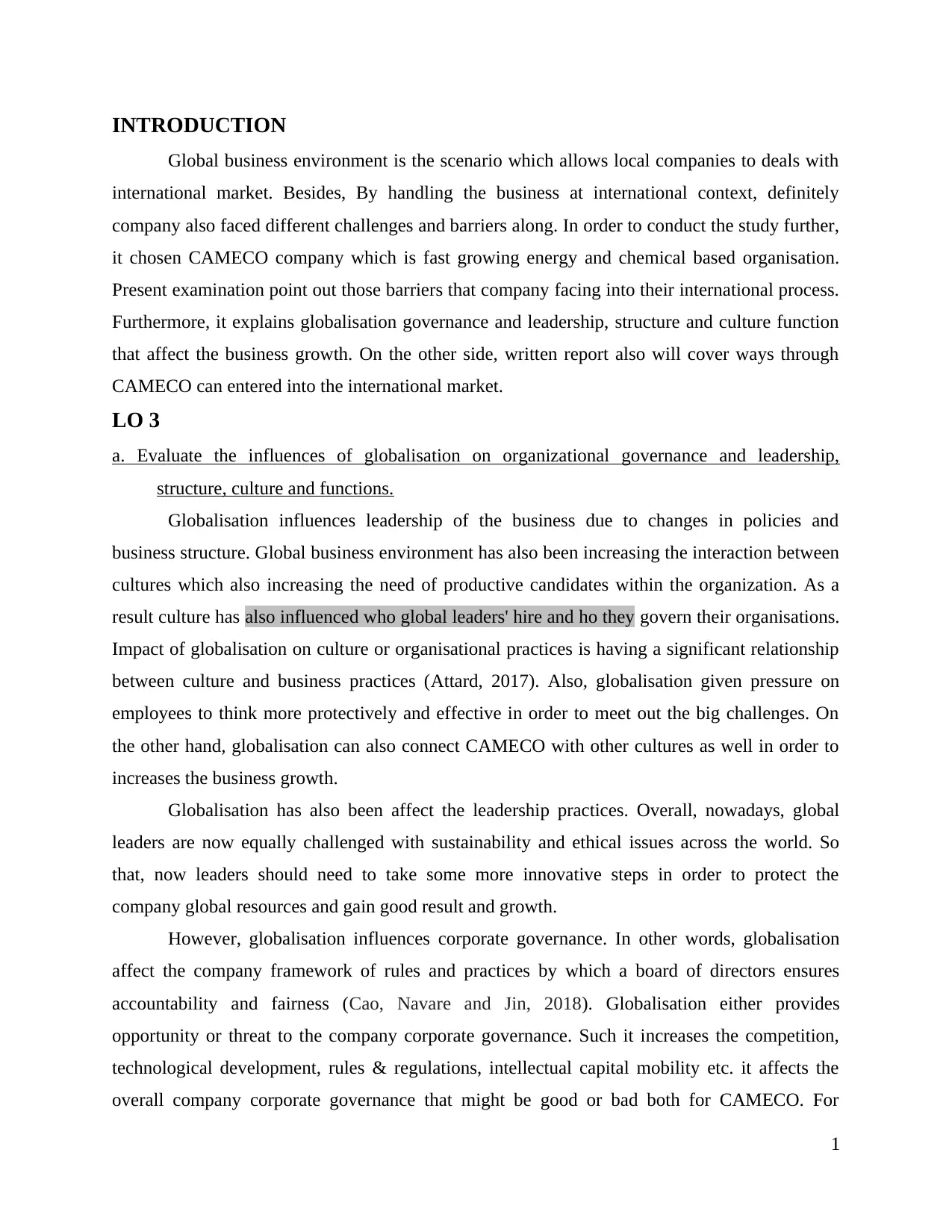
INTRODUCTION
Global business environment is the scenario which allows local companies to deals with
international market. Besides, By handling the business at international context, definitely
company also faced different challenges and barriers along. In order to conduct the study further,
it chosen CAMECO company which is fast growing energy and chemical based organisation.
Present examination point out those barriers that company facing into their international process.
Furthermore, it explains globalisation governance and leadership, structure and culture function
that affect the business growth. On the other side, written report also will cover ways through
CAMECO can entered into the international market.
LO 3
a. Evaluate the influences of globalisation on organizational governance and leadership,
structure, culture and functions.
Globalisation influences leadership of the business due to changes in policies and
business structure. Global business environment has also been increasing the interaction between
cultures which also increasing the need of productive candidates within the organization. As a
result culture has also influenced who global leaders' hire and ho they govern their organisations.
Impact of globalisation on culture or organisational practices is having a significant relationship
between culture and business practices (Attard, 2017). Also, globalisation given pressure on
employees to think more protectively and effective in order to meet out the big challenges. On
the other hand, globalisation can also connect CAMECO with other cultures as well in order to
increases the business growth.
Globalisation has also been affect the leadership practices. Overall, nowadays, global
leaders are now equally challenged with sustainability and ethical issues across the world. So
that, now leaders should need to take some more innovative steps in order to protect the
company global resources and gain good result and growth.
However, globalisation influences corporate governance. In other words, globalisation
affect the company framework of rules and practices by which a board of directors ensures
accountability and fairness (Cao, Navare and Jin, 2018). Globalisation either provides
opportunity or threat to the company corporate governance. Such it increases the competition,
technological development, rules & regulations, intellectual capital mobility etc. it affects the
overall company corporate governance that might be good or bad both for CAMECO. For
1
Global business environment is the scenario which allows local companies to deals with
international market. Besides, By handling the business at international context, definitely
company also faced different challenges and barriers along. In order to conduct the study further,
it chosen CAMECO company which is fast growing energy and chemical based organisation.
Present examination point out those barriers that company facing into their international process.
Furthermore, it explains globalisation governance and leadership, structure and culture function
that affect the business growth. On the other side, written report also will cover ways through
CAMECO can entered into the international market.
LO 3
a. Evaluate the influences of globalisation on organizational governance and leadership,
structure, culture and functions.
Globalisation influences leadership of the business due to changes in policies and
business structure. Global business environment has also been increasing the interaction between
cultures which also increasing the need of productive candidates within the organization. As a
result culture has also influenced who global leaders' hire and ho they govern their organisations.
Impact of globalisation on culture or organisational practices is having a significant relationship
between culture and business practices (Attard, 2017). Also, globalisation given pressure on
employees to think more protectively and effective in order to meet out the big challenges. On
the other hand, globalisation can also connect CAMECO with other cultures as well in order to
increases the business growth.
Globalisation has also been affect the leadership practices. Overall, nowadays, global
leaders are now equally challenged with sustainability and ethical issues across the world. So
that, now leaders should need to take some more innovative steps in order to protect the
company global resources and gain good result and growth.
However, globalisation influences corporate governance. In other words, globalisation
affect the company framework of rules and practices by which a board of directors ensures
accountability and fairness (Cao, Navare and Jin, 2018). Globalisation either provides
opportunity or threat to the company corporate governance. Such it increases the competition,
technological development, rules & regulations, intellectual capital mobility etc. it affects the
overall company corporate governance that might be good or bad both for CAMECO. For
1
⊘ This is a preview!⊘
Do you want full access?
Subscribe today to unlock all pages.

Trusted by 1+ million students worldwide
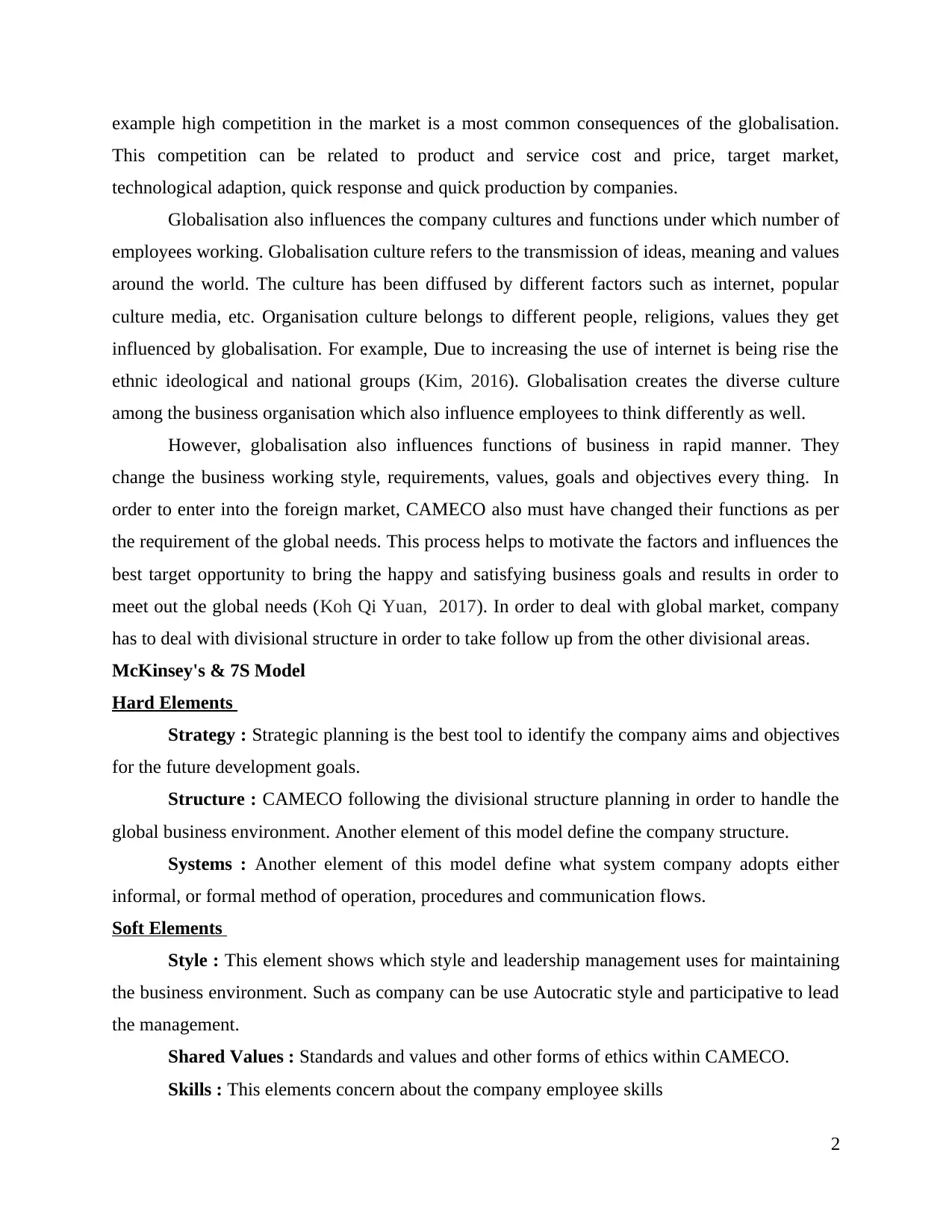
example high competition in the market is a most common consequences of the globalisation.
This competition can be related to product and service cost and price, target market,
technological adaption, quick response and quick production by companies.
Globalisation also influences the company cultures and functions under which number of
employees working. Globalisation culture refers to the transmission of ideas, meaning and values
around the world. The culture has been diffused by different factors such as internet, popular
culture media, etc. Organisation culture belongs to different people, religions, values they get
influenced by globalisation. For example, Due to increasing the use of internet is being rise the
ethnic ideological and national groups (Kim, 2016). Globalisation creates the diverse culture
among the business organisation which also influence employees to think differently as well.
However, globalisation also influences functions of business in rapid manner. They
change the business working style, requirements, values, goals and objectives every thing. In
order to enter into the foreign market, CAMECO also must have changed their functions as per
the requirement of the global needs. This process helps to motivate the factors and influences the
best target opportunity to bring the happy and satisfying business goals and results in order to
meet out the global needs (Koh Qi Yuan, 2017). In order to deal with global market, company
has to deal with divisional structure in order to take follow up from the other divisional areas.
McKinsey's & 7S Model
Hard Elements
Strategy : Strategic planning is the best tool to identify the company aims and objectives
for the future development goals.
Structure : CAMECO following the divisional structure planning in order to handle the
global business environment. Another element of this model define the company structure.
Systems : Another element of this model define what system company adopts either
informal, or formal method of operation, procedures and communication flows.
Soft Elements
Style : This element shows which style and leadership management uses for maintaining
the business environment. Such as company can be use Autocratic style and participative to lead
the management.
Shared Values : Standards and values and other forms of ethics within CAMECO.
Skills : This elements concern about the company employee skills
2
This competition can be related to product and service cost and price, target market,
technological adaption, quick response and quick production by companies.
Globalisation also influences the company cultures and functions under which number of
employees working. Globalisation culture refers to the transmission of ideas, meaning and values
around the world. The culture has been diffused by different factors such as internet, popular
culture media, etc. Organisation culture belongs to different people, religions, values they get
influenced by globalisation. For example, Due to increasing the use of internet is being rise the
ethnic ideological and national groups (Kim, 2016). Globalisation creates the diverse culture
among the business organisation which also influence employees to think differently as well.
However, globalisation also influences functions of business in rapid manner. They
change the business working style, requirements, values, goals and objectives every thing. In
order to enter into the foreign market, CAMECO also must have changed their functions as per
the requirement of the global needs. This process helps to motivate the factors and influences the
best target opportunity to bring the happy and satisfying business goals and results in order to
meet out the global needs (Koh Qi Yuan, 2017). In order to deal with global market, company
has to deal with divisional structure in order to take follow up from the other divisional areas.
McKinsey's & 7S Model
Hard Elements
Strategy : Strategic planning is the best tool to identify the company aims and objectives
for the future development goals.
Structure : CAMECO following the divisional structure planning in order to handle the
global business environment. Another element of this model define the company structure.
Systems : Another element of this model define what system company adopts either
informal, or formal method of operation, procedures and communication flows.
Soft Elements
Style : This element shows which style and leadership management uses for maintaining
the business environment. Such as company can be use Autocratic style and participative to lead
the management.
Shared Values : Standards and values and other forms of ethics within CAMECO.
Skills : This elements concern about the company employee skills
2
Paraphrase This Document
Need a fresh take? Get an instant paraphrase of this document with our AI Paraphraser
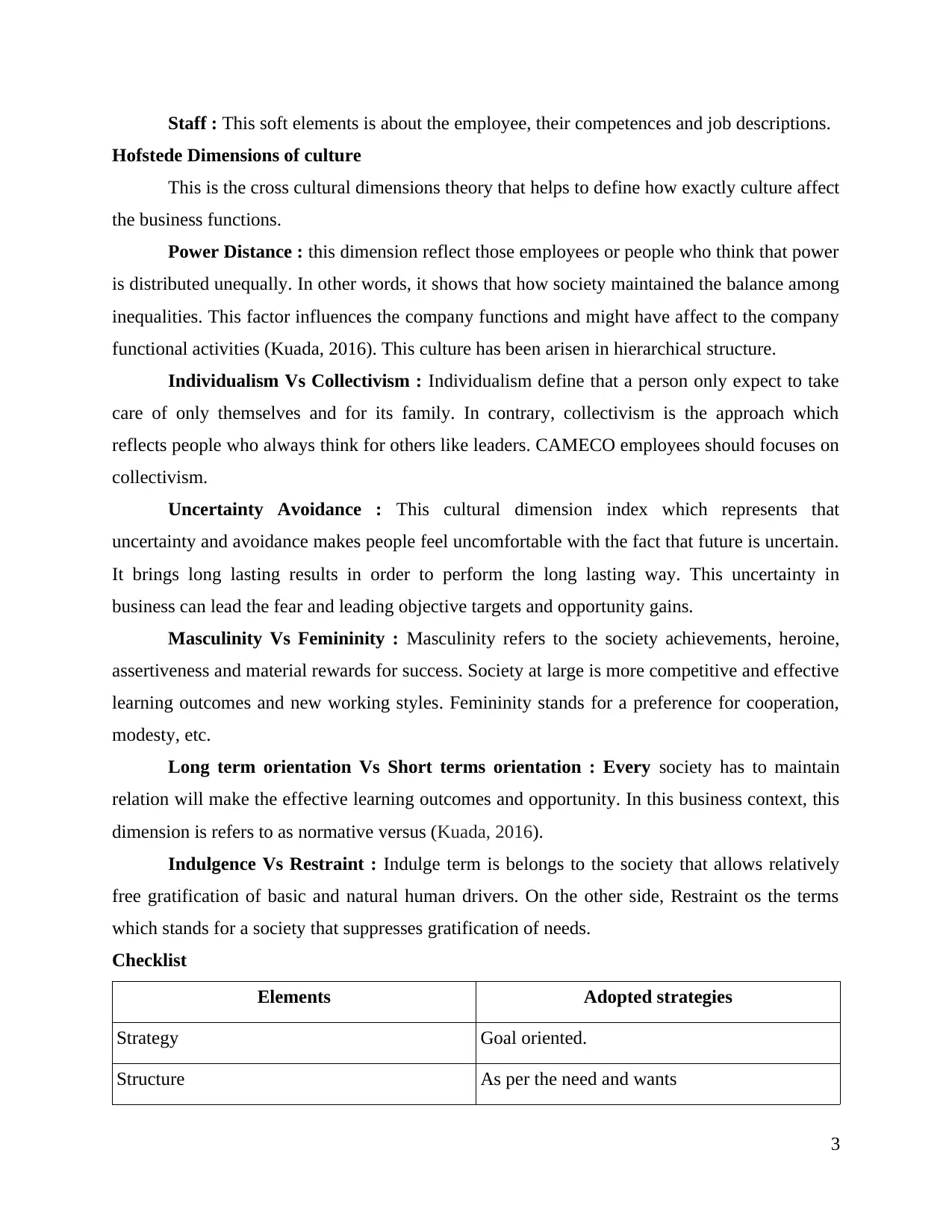
Staff : This soft elements is about the employee, their competences and job descriptions.
Hofstede Dimensions of culture
This is the cross cultural dimensions theory that helps to define how exactly culture affect
the business functions.
Power Distance : this dimension reflect those employees or people who think that power
is distributed unequally. In other words, it shows that how society maintained the balance among
inequalities. This factor influences the company functions and might have affect to the company
functional activities (Kuada, 2016). This culture has been arisen in hierarchical structure.
Individualism Vs Collectivism : Individualism define that a person only expect to take
care of only themselves and for its family. In contrary, collectivism is the approach which
reflects people who always think for others like leaders. CAMECO employees should focuses on
collectivism.
Uncertainty Avoidance : This cultural dimension index which represents that
uncertainty and avoidance makes people feel uncomfortable with the fact that future is uncertain.
It brings long lasting results in order to perform the long lasting way. This uncertainty in
business can lead the fear and leading objective targets and opportunity gains.
Masculinity Vs Femininity : Masculinity refers to the society achievements, heroine,
assertiveness and material rewards for success. Society at large is more competitive and effective
learning outcomes and new working styles. Femininity stands for a preference for cooperation,
modesty, etc.
Long term orientation Vs Short terms orientation : Every society has to maintain
relation will make the effective learning outcomes and opportunity. In this business context, this
dimension is refers to as normative versus (Kuada, 2016).
Indulgence Vs Restraint : Indulge term is belongs to the society that allows relatively
free gratification of basic and natural human drivers. On the other side, Restraint os the terms
which stands for a society that suppresses gratification of needs.
Checklist
Elements Adopted strategies
Strategy Goal oriented.
Structure As per the need and wants
3
Hofstede Dimensions of culture
This is the cross cultural dimensions theory that helps to define how exactly culture affect
the business functions.
Power Distance : this dimension reflect those employees or people who think that power
is distributed unequally. In other words, it shows that how society maintained the balance among
inequalities. This factor influences the company functions and might have affect to the company
functional activities (Kuada, 2016). This culture has been arisen in hierarchical structure.
Individualism Vs Collectivism : Individualism define that a person only expect to take
care of only themselves and for its family. In contrary, collectivism is the approach which
reflects people who always think for others like leaders. CAMECO employees should focuses on
collectivism.
Uncertainty Avoidance : This cultural dimension index which represents that
uncertainty and avoidance makes people feel uncomfortable with the fact that future is uncertain.
It brings long lasting results in order to perform the long lasting way. This uncertainty in
business can lead the fear and leading objective targets and opportunity gains.
Masculinity Vs Femininity : Masculinity refers to the society achievements, heroine,
assertiveness and material rewards for success. Society at large is more competitive and effective
learning outcomes and new working styles. Femininity stands for a preference for cooperation,
modesty, etc.
Long term orientation Vs Short terms orientation : Every society has to maintain
relation will make the effective learning outcomes and opportunity. In this business context, this
dimension is refers to as normative versus (Kuada, 2016).
Indulgence Vs Restraint : Indulge term is belongs to the society that allows relatively
free gratification of basic and natural human drivers. On the other side, Restraint os the terms
which stands for a society that suppresses gratification of needs.
Checklist
Elements Adopted strategies
Strategy Goal oriented.
Structure As per the need and wants
3

Systems Finding new goals and standards.
Skills Communication skills, interpersonal skills.
Styles Participative, Autocratic
Staff Employees, managers
Shared values Moral ethics, culture
b. Evaluating the influences of ethical and sustainable globalisation on organisational functions.
Sustainable business environment is now become the vital topic or need of business
which deals with international market. In other words, international influences such as ethic,
sustainability all these factors somehow affect the function of the organisations. The foremost
term in the business is organizational ethics within the global context more generally.
In other words, sustainable development is now becoming the essential topic in present
business environment (Laudon and Traver, 2016). In which companies must ensure safe
environment, good harmless products for people, it helps to define the effective learning
outcomes and goals. How company engaged with the good ethic environment by applying the
good environment regulations, make sure the company environment and long lasting result
oriented goals and services.
Ethical behaviour and challenges affect the business organisation in several manners in
order to meet out the global strategic goals. There are different factors of ethical that affect the
business functions. Such as company should need to follow the ethical implications of foreign
country where they plan to open its new operations. There society behaviour and sustainability
environment should also play an important role that sometimes affect the business environment
and goals (Taran and et.al., 2016).
LO 4
a. Evaluating the different ways decision making can work effectively in a global context.
In business context decision making plays a most important role in order to sustained the
market growth and many more opportunities for the business success level. Well decision
making approach that directly affect the business function an organisation objective in order to
meet out the company aims and objectives. Besides, global environment is highly uncertain and
unstable in order to adopt the changes (Minto-Coy, 2016). It is important that there are several
4
Skills Communication skills, interpersonal skills.
Styles Participative, Autocratic
Staff Employees, managers
Shared values Moral ethics, culture
b. Evaluating the influences of ethical and sustainable globalisation on organisational functions.
Sustainable business environment is now become the vital topic or need of business
which deals with international market. In other words, international influences such as ethic,
sustainability all these factors somehow affect the function of the organisations. The foremost
term in the business is organizational ethics within the global context more generally.
In other words, sustainable development is now becoming the essential topic in present
business environment (Laudon and Traver, 2016). In which companies must ensure safe
environment, good harmless products for people, it helps to define the effective learning
outcomes and goals. How company engaged with the good ethic environment by applying the
good environment regulations, make sure the company environment and long lasting result
oriented goals and services.
Ethical behaviour and challenges affect the business organisation in several manners in
order to meet out the global strategic goals. There are different factors of ethical that affect the
business functions. Such as company should need to follow the ethical implications of foreign
country where they plan to open its new operations. There society behaviour and sustainability
environment should also play an important role that sometimes affect the business environment
and goals (Taran and et.al., 2016).
LO 4
a. Evaluating the different ways decision making can work effectively in a global context.
In business context decision making plays a most important role in order to sustained the
market growth and many more opportunities for the business success level. Well decision
making approach that directly affect the business function an organisation objective in order to
meet out the company aims and objectives. Besides, global environment is highly uncertain and
unstable in order to adopt the changes (Minto-Coy, 2016). It is important that there are several
4
⊘ This is a preview!⊘
Do you want full access?
Subscribe today to unlock all pages.

Trusted by 1+ million students worldwide
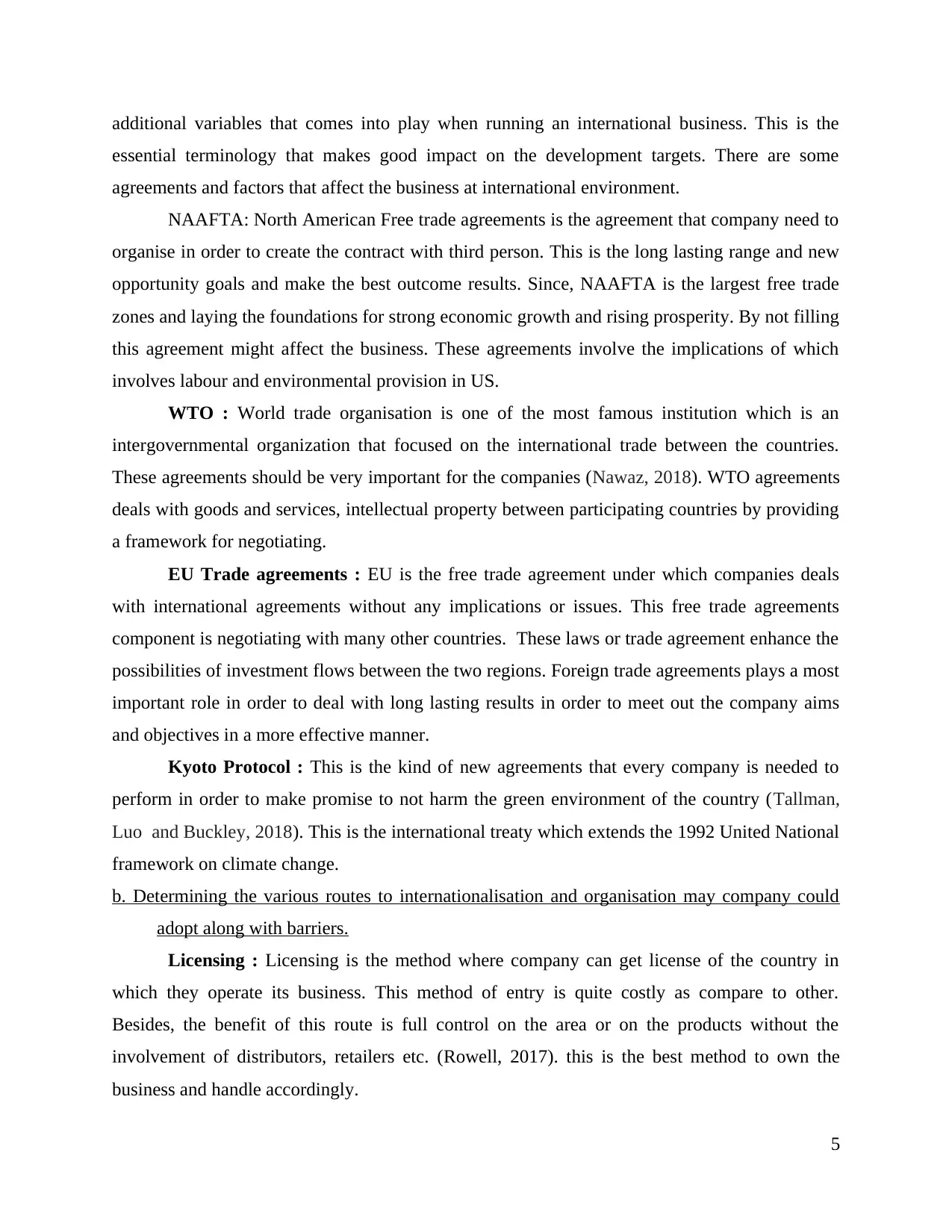
additional variables that comes into play when running an international business. This is the
essential terminology that makes good impact on the development targets. There are some
agreements and factors that affect the business at international environment.
NAAFTA: North American Free trade agreements is the agreement that company need to
organise in order to create the contract with third person. This is the long lasting range and new
opportunity goals and make the best outcome results. Since, NAAFTA is the largest free trade
zones and laying the foundations for strong economic growth and rising prosperity. By not filling
this agreement might affect the business. These agreements involve the implications of which
involves labour and environmental provision in US.
WTO : World trade organisation is one of the most famous institution which is an
intergovernmental organization that focused on the international trade between the countries.
These agreements should be very important for the companies (Nawaz, 2018). WTO agreements
deals with goods and services, intellectual property between participating countries by providing
a framework for negotiating.
EU Trade agreements : EU is the free trade agreement under which companies deals
with international agreements without any implications or issues. This free trade agreements
component is negotiating with many other countries. These laws or trade agreement enhance the
possibilities of investment flows between the two regions. Foreign trade agreements plays a most
important role in order to deal with long lasting results in order to meet out the company aims
and objectives in a more effective manner.
Kyoto Protocol : This is the kind of new agreements that every company is needed to
perform in order to make promise to not harm the green environment of the country (Tallman,
Luo and Buckley, 2018). This is the international treaty which extends the 1992 United National
framework on climate change.
b. Determining the various routes to internationalisation and organisation may company could
adopt along with barriers.
Licensing : Licensing is the method where company can get license of the country in
which they operate its business. This method of entry is quite costly as compare to other.
Besides, the benefit of this route is full control on the area or on the products without the
involvement of distributors, retailers etc. (Rowell, 2017). this is the best method to own the
business and handle accordingly.
5
essential terminology that makes good impact on the development targets. There are some
agreements and factors that affect the business at international environment.
NAAFTA: North American Free trade agreements is the agreement that company need to
organise in order to create the contract with third person. This is the long lasting range and new
opportunity goals and make the best outcome results. Since, NAAFTA is the largest free trade
zones and laying the foundations for strong economic growth and rising prosperity. By not filling
this agreement might affect the business. These agreements involve the implications of which
involves labour and environmental provision in US.
WTO : World trade organisation is one of the most famous institution which is an
intergovernmental organization that focused on the international trade between the countries.
These agreements should be very important for the companies (Nawaz, 2018). WTO agreements
deals with goods and services, intellectual property between participating countries by providing
a framework for negotiating.
EU Trade agreements : EU is the free trade agreement under which companies deals
with international agreements without any implications or issues. This free trade agreements
component is negotiating with many other countries. These laws or trade agreement enhance the
possibilities of investment flows between the two regions. Foreign trade agreements plays a most
important role in order to deal with long lasting results in order to meet out the company aims
and objectives in a more effective manner.
Kyoto Protocol : This is the kind of new agreements that every company is needed to
perform in order to make promise to not harm the green environment of the country (Tallman,
Luo and Buckley, 2018). This is the international treaty which extends the 1992 United National
framework on climate change.
b. Determining the various routes to internationalisation and organisation may company could
adopt along with barriers.
Licensing : Licensing is the method where company can get license of the country in
which they operate its business. This method of entry is quite costly as compare to other.
Besides, the benefit of this route is full control on the area or on the products without the
involvement of distributors, retailers etc. (Rowell, 2017). this is the best method to own the
business and handle accordingly.
5
Paraphrase This Document
Need a fresh take? Get an instant paraphrase of this document with our AI Paraphraser
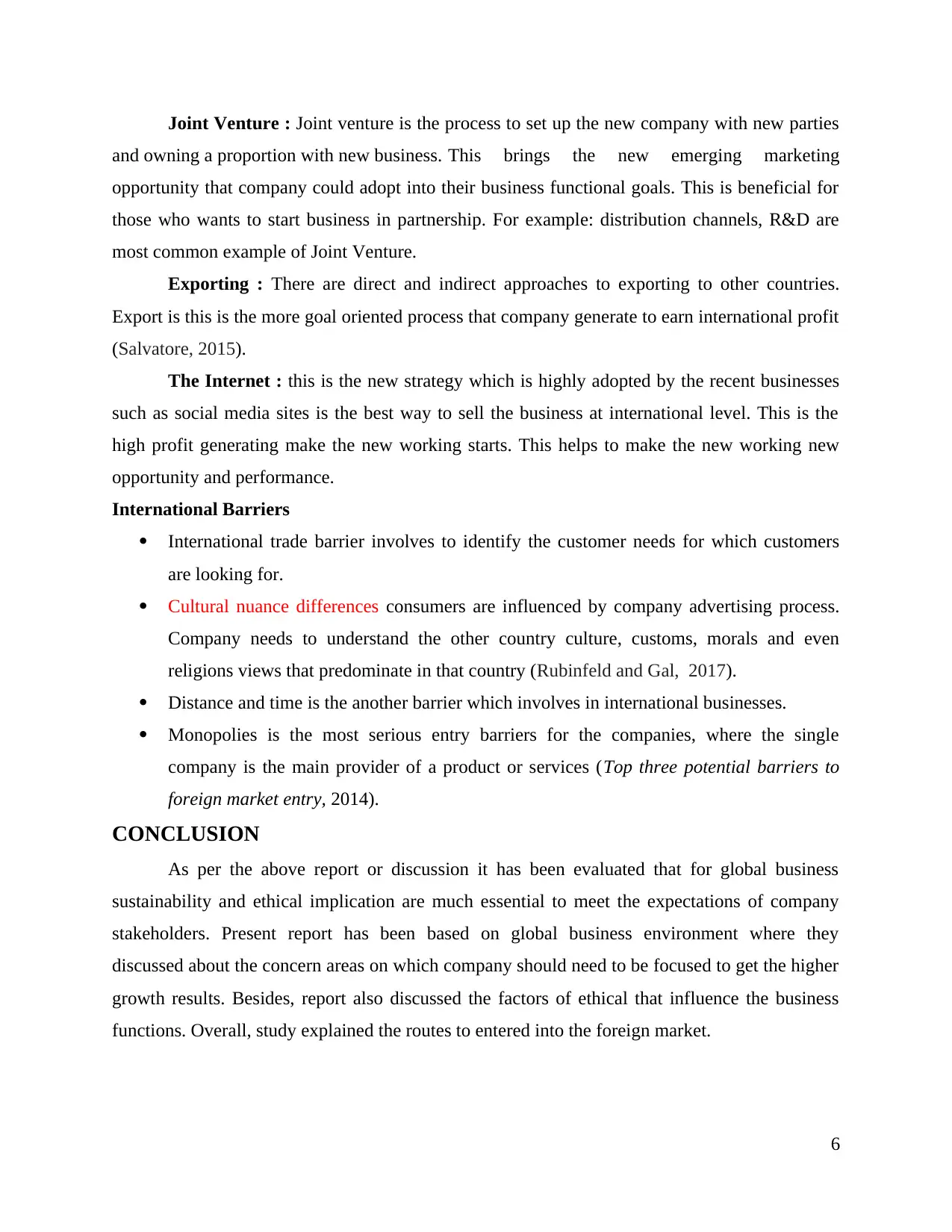
Joint Venture : Joint venture is the process to set up the new company with new parties
and owning a proportion with new business. This brings the new emerging marketing
opportunity that company could adopt into their business functional goals. This is beneficial for
those who wants to start business in partnership. For example: distribution channels, R&D are
most common example of Joint Venture.
Exporting : There are direct and indirect approaches to exporting to other countries.
Export is this is the more goal oriented process that company generate to earn international profit
(Salvatore, 2015).
The Internet : this is the new strategy which is highly adopted by the recent businesses
such as social media sites is the best way to sell the business at international level. This is the
high profit generating make the new working starts. This helps to make the new working new
opportunity and performance.
International Barriers
International trade barrier involves to identify the customer needs for which customers
are looking for.
Cultural nuance differences consumers are influenced by company advertising process.
Company needs to understand the other country culture, customs, morals and even
religions views that predominate in that country (Rubinfeld and Gal, 2017).
Distance and time is the another barrier which involves in international businesses.
Monopolies is the most serious entry barriers for the companies, where the single
company is the main provider of a product or services (Top three potential barriers to
foreign market entry, 2014).
CONCLUSION
As per the above report or discussion it has been evaluated that for global business
sustainability and ethical implication are much essential to meet the expectations of company
stakeholders. Present report has been based on global business environment where they
discussed about the concern areas on which company should need to be focused to get the higher
growth results. Besides, report also discussed the factors of ethical that influence the business
functions. Overall, study explained the routes to entered into the foreign market.
6
and owning a proportion with new business. This brings the new emerging marketing
opportunity that company could adopt into their business functional goals. This is beneficial for
those who wants to start business in partnership. For example: distribution channels, R&D are
most common example of Joint Venture.
Exporting : There are direct and indirect approaches to exporting to other countries.
Export is this is the more goal oriented process that company generate to earn international profit
(Salvatore, 2015).
The Internet : this is the new strategy which is highly adopted by the recent businesses
such as social media sites is the best way to sell the business at international level. This is the
high profit generating make the new working starts. This helps to make the new working new
opportunity and performance.
International Barriers
International trade barrier involves to identify the customer needs for which customers
are looking for.
Cultural nuance differences consumers are influenced by company advertising process.
Company needs to understand the other country culture, customs, morals and even
religions views that predominate in that country (Rubinfeld and Gal, 2017).
Distance and time is the another barrier which involves in international businesses.
Monopolies is the most serious entry barriers for the companies, where the single
company is the main provider of a product or services (Top three potential barriers to
foreign market entry, 2014).
CONCLUSION
As per the above report or discussion it has been evaluated that for global business
sustainability and ethical implication are much essential to meet the expectations of company
stakeholders. Present report has been based on global business environment where they
discussed about the concern areas on which company should need to be focused to get the higher
growth results. Besides, report also discussed the factors of ethical that influence the business
functions. Overall, study explained the routes to entered into the foreign market.
6
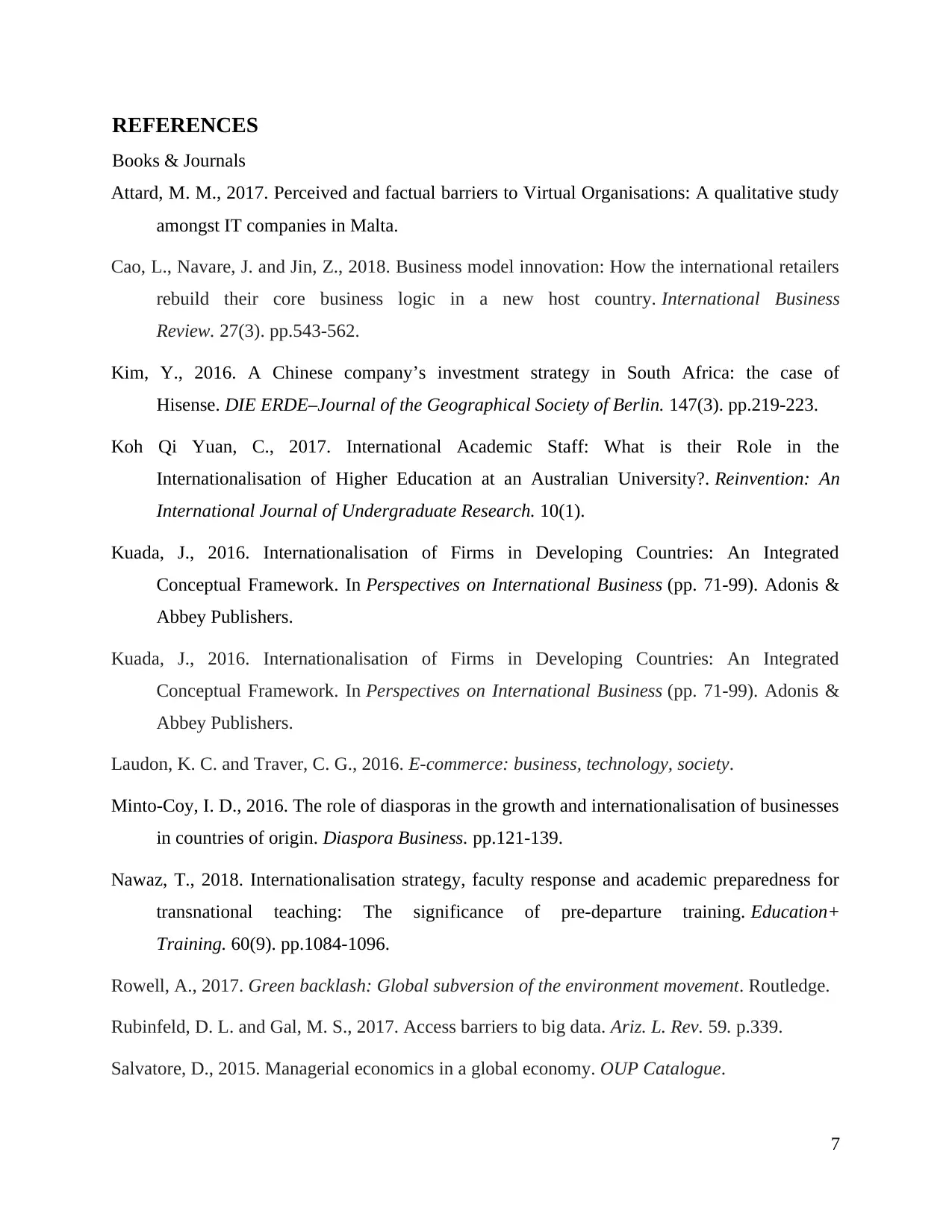
REFERENCES
Books & Journals
Attard, M. M., 2017. Perceived and factual barriers to Virtual Organisations: A qualitative study
amongst IT companies in Malta.
Cao, L., Navare, J. and Jin, Z., 2018. Business model innovation: How the international retailers
rebuild their core business logic in a new host country. International Business
Review. 27(3). pp.543-562.
Kim, Y., 2016. A Chinese company’s investment strategy in South Africa: the case of
Hisense. DIE ERDE–Journal of the Geographical Society of Berlin. 147(3). pp.219-223.
Koh Qi Yuan, C., 2017. International Academic Staff: What is their Role in the
Internationalisation of Higher Education at an Australian University?. Reinvention: An
International Journal of Undergraduate Research. 10(1).
Kuada, J., 2016. Internationalisation of Firms in Developing Countries: An Integrated
Conceptual Framework. In Perspectives on International Business (pp. 71-99). Adonis &
Abbey Publishers.
Kuada, J., 2016. Internationalisation of Firms in Developing Countries: An Integrated
Conceptual Framework. In Perspectives on International Business (pp. 71-99). Adonis &
Abbey Publishers.
Laudon, K. C. and Traver, C. G., 2016. E-commerce: business, technology, society.
Minto-Coy, I. D., 2016. The role of diasporas in the growth and internationalisation of businesses
in countries of origin. Diaspora Business. pp.121-139.
Nawaz, T., 2018. Internationalisation strategy, faculty response and academic preparedness for
transnational teaching: The significance of pre-departure training. Education+
Training. 60(9). pp.1084-1096.
Rowell, A., 2017. Green backlash: Global subversion of the environment movement. Routledge.
Rubinfeld, D. L. and Gal, M. S., 2017. Access barriers to big data. Ariz. L. Rev. 59. p.339.
Salvatore, D., 2015. Managerial economics in a global economy. OUP Catalogue.
7
Books & Journals
Attard, M. M., 2017. Perceived and factual barriers to Virtual Organisations: A qualitative study
amongst IT companies in Malta.
Cao, L., Navare, J. and Jin, Z., 2018. Business model innovation: How the international retailers
rebuild their core business logic in a new host country. International Business
Review. 27(3). pp.543-562.
Kim, Y., 2016. A Chinese company’s investment strategy in South Africa: the case of
Hisense. DIE ERDE–Journal of the Geographical Society of Berlin. 147(3). pp.219-223.
Koh Qi Yuan, C., 2017. International Academic Staff: What is their Role in the
Internationalisation of Higher Education at an Australian University?. Reinvention: An
International Journal of Undergraduate Research. 10(1).
Kuada, J., 2016. Internationalisation of Firms in Developing Countries: An Integrated
Conceptual Framework. In Perspectives on International Business (pp. 71-99). Adonis &
Abbey Publishers.
Kuada, J., 2016. Internationalisation of Firms in Developing Countries: An Integrated
Conceptual Framework. In Perspectives on International Business (pp. 71-99). Adonis &
Abbey Publishers.
Laudon, K. C. and Traver, C. G., 2016. E-commerce: business, technology, society.
Minto-Coy, I. D., 2016. The role of diasporas in the growth and internationalisation of businesses
in countries of origin. Diaspora Business. pp.121-139.
Nawaz, T., 2018. Internationalisation strategy, faculty response and academic preparedness for
transnational teaching: The significance of pre-departure training. Education+
Training. 60(9). pp.1084-1096.
Rowell, A., 2017. Green backlash: Global subversion of the environment movement. Routledge.
Rubinfeld, D. L. and Gal, M. S., 2017. Access barriers to big data. Ariz. L. Rev. 59. p.339.
Salvatore, D., 2015. Managerial economics in a global economy. OUP Catalogue.
7
⊘ This is a preview!⊘
Do you want full access?
Subscribe today to unlock all pages.

Trusted by 1+ million students worldwide
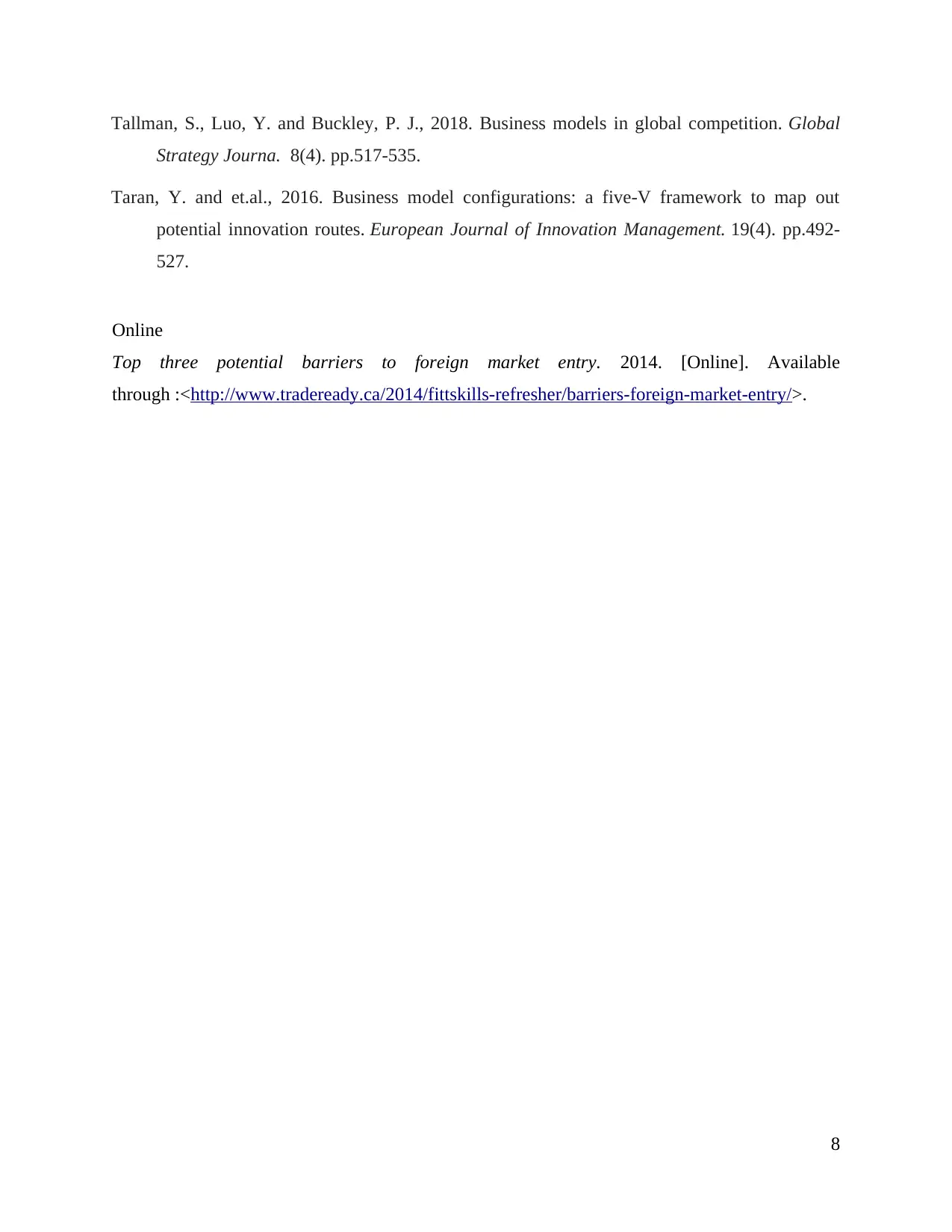
Tallman, S., Luo, Y. and Buckley, P. J., 2018. Business models in global competition. Global
Strategy Journa. 8(4). pp.517-535.
Taran, Y. and et.al., 2016. Business model configurations: a five-V framework to map out
potential innovation routes. European Journal of Innovation Management. 19(4). pp.492-
527.
Online
Top three potential barriers to foreign market entry. 2014. [Online]. Available
through :<http://www.tradeready.ca/2014/fittskills-refresher/barriers-foreign-market-entry/>.
8
Strategy Journa. 8(4). pp.517-535.
Taran, Y. and et.al., 2016. Business model configurations: a five-V framework to map out
potential innovation routes. European Journal of Innovation Management. 19(4). pp.492-
527.
Online
Top three potential barriers to foreign market entry. 2014. [Online]. Available
through :<http://www.tradeready.ca/2014/fittskills-refresher/barriers-foreign-market-entry/>.
8
Paraphrase This Document
Need a fresh take? Get an instant paraphrase of this document with our AI Paraphraser

9
1 out of 11
Related Documents
Your All-in-One AI-Powered Toolkit for Academic Success.
+13062052269
info@desklib.com
Available 24*7 on WhatsApp / Email
![[object Object]](/_next/static/media/star-bottom.7253800d.svg)
Unlock your academic potential
Copyright © 2020–2025 A2Z Services. All Rights Reserved. Developed and managed by ZUCOL.





